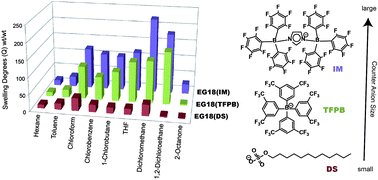Counter anion dependent swelling behaviour of poly(octadecyl acrylate)-based lipophilic polyelectrolyte gels as superabsorbent polymers for organic solvents†
Abstract
Molecular design of superabsorbent materials for organic

* Corresponding authors
a Department of Chemistry and Biochemistry, Graduate School of Engineering, Kyushu University, 744 Motooka, Nishi, Fukuoka, Japan
b
Department of Chemistry, Graduate School of Science, Hokkaido University, Kita 10, Nishi 8, Kita, Sapporo 060-0810, Japan
E-mail:
sadatcm@mail.sci.hokudai.ac.jp
Molecular design of superabsorbent materials for organic

 Please wait while we load your content...
Something went wrong. Try again?
Please wait while we load your content...
Something went wrong. Try again?
T. Ono, M. Ohta, K. Iseda and K. Sada, Soft Matter, 2012, 8, 3700 DOI: 10.1039/C2SM06804D
To request permission to reproduce material from this article, please go to the Copyright Clearance Center request page.
If you are an author contributing to an RSC publication, you do not need to request permission provided correct acknowledgement is given.
If you are the author of this article, you do not need to request permission to reproduce figures and diagrams provided correct acknowledgement is given. If you want to reproduce the whole article in a third-party publication (excluding your thesis/dissertation for which permission is not required) please go to the Copyright Clearance Center request page.
Read more about how to correctly acknowledge RSC content.
 Fetching data from CrossRef.
Fetching data from CrossRef.
This may take some time to load.
Loading related content
